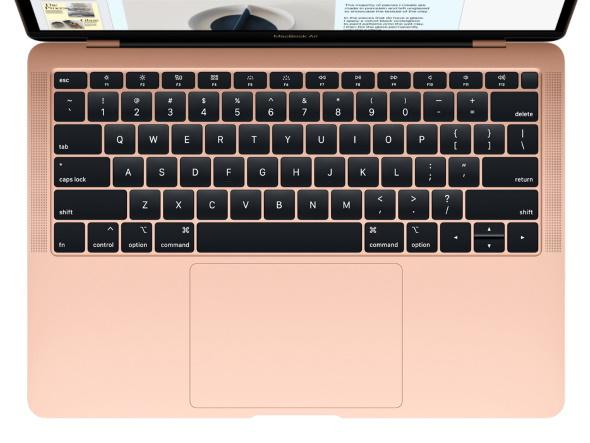"Air and I" is a series of short-term intensive reviews of the top configuration (256GB SSD) for over-the-counter sales of the "MacBook Air (Mid 2019)" released on July 11th. For the first time, I checked the model number of the CPU and the performance of the SSD.
I am very concerned about "keyboard" and "external connection" when I put it into actual work. Therefore, I would like to focus on these in this review.
A diagram that approximates the author's work environment (display is different)The keyboards of the recent MacBook family use Apple's unique "butterfly structure" keys. The MacBook Air (Mid 2019) I'm using this time also uses a butterfly keyboard.
The individual being reviewed this time is a retail model, so it has a JIS (Japanese) layout keyboard. At the Apple Store and some mass retailers, the following layout keyboards can be installed by customization. It would be good to select according to your preference and the language you use (input).
The JIS layout keyboard reviewed this time. Compared to other language keyboards, there are two Japanese-related keys, the positions of the "Control key" and "Caps key" are reversed, and the position of the "Fn key" is different (shooting : Wataru Yano) American English layout keyboard. Compared to the JIS layout, the positions of some symbols are different, but the space key is longer. In terms of alignment affinity, it is very easy to handle for me because it is almost the same as the American English keyboard of Windows PC (the Windows notebook PC I usually use is equipped with an American English keyboard)Butterfly key Thinness is the biggest advantage. It is more advantageous for thinning than the general scissor (pantograph) structure key, and there is an advantage that the thickness of the entire main body can be suppressed. It is a convenient structure to achieve a slim and stylish design.
On the other hand, there is also a disadvantage that it is easy to get tired. If you hit the butterfly keys in the same way as you would on other keyboards (especially desktop keyboards with deep strokes), you'll unknowingly feel the recoil in your fingers, wrists, arms, and even shoulders. As a result, it is easy to feel physical fatigue such as "my fingers are tired" and "my shoulders are stiff".
This easiness of fatigue can be greatly alleviated if you think "Butterfly keys are like this" and try to type with a light touch. Fatigue when hitting can be overcome to some extent by getting used to it. However, since it is "to a certain extent", some people may not be able to relieve the stress of key input even if they are "too tired ...".

If you are going to type sentences continuously for a certain amount of time (more than 2-3 hours) on your PC, we recommend that you take some time to "try out" the butterfly keyboard before purchasing.
The butterfly keyboard has been improved to make it easier to type. However, it is still a keyboard that chooses people, so if possible, I would like to take some time in advance and try it outThe external connection ports of the MacBook Air (Mid 2019) are Thunderbolt 3 terminals x 2 and earphone microphone terminals x 1 and very simple. The Thunderbolt 3 terminal also serves as a USB 3.1 Type-C terminal, power input via USB Power Delivery (USB PD), and video output via DisplayPort.
Equipped with two Thunderbolt 3 terminals on the left side (photographed by Wataru Yano) Equipped with an earphone microphone terminal on the right side (photographed by Wataru Yano)As you can see, the external connection port of the MacBook Air (Mid 2019) is Very few. If one is used for power input, there is only one remaining terminal... If you say that, it seems to be lacking in expandability.
However, if you use a port replicator (multi-hub, docking station) that supports USB Type-C or Thunderbolt 3, you can cover the lack of expandability at a high level. In particular, if you attach and detach multiple devices at home or at work each time, using a port replicator will allow you to attach and detach them all at once, which will rather improve convenience.
The problem is the price, but if you narrow down the functions you need for the USB Type-C connection, you can buy it from the late 5000 yen range, and if you have multiple functions, you can buy it from less than 10,000 yen. The Thunderbolt 3 connection is slightly more expensive, starting in the low 20,000 yen range, but it has more functions than the USB Type-C connection, such as simultaneous output of multiple screens and the addition of various connection interfaces. many.
It would be a good idea to buy the necessary port replicator for your purpose.
The USB Type-C multi-hub "JCD384" (photo) made by j5 create in Taiwan is equipped with USB PD power input, HDMI output terminal, USB 3.0 Type-A terminal x 3, SD memory card slot, etc. If you put one of these in your home or office, you can get a very comfortable connection environmentThere are many opportunities to output video on the go and exchange data with USB memory or SD memory cards. In such cases, it is convenient to carry a small port replicator or a single-function adapter in your bag.
If it's a cheap USB 3.0 Type-A conversion adapter, you'll get change if it's 1,000 yen. Video conversion adapters can be purchased for 1,000 to 3,000 yen, depending on the destination standard.
In preparation for connecting to devices other than USB Type-C (or Thunderbolt 3) on the go, it's a good idea to bring a compact conversion adapter (pictured is a conversion adapter to DisplayPort)Copyright © ITmedia, Inc .All Rights Reserved.